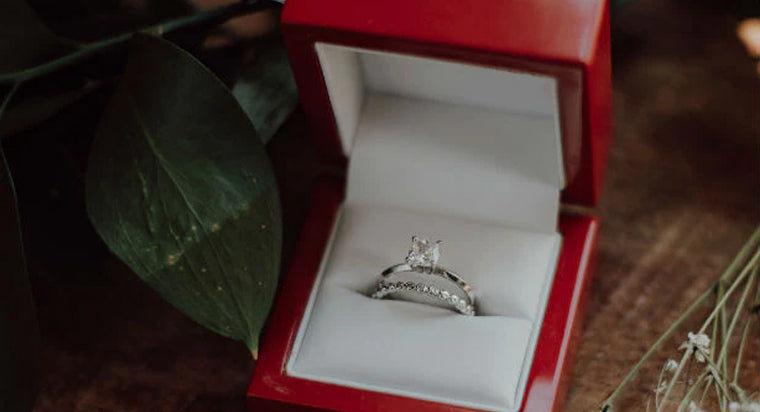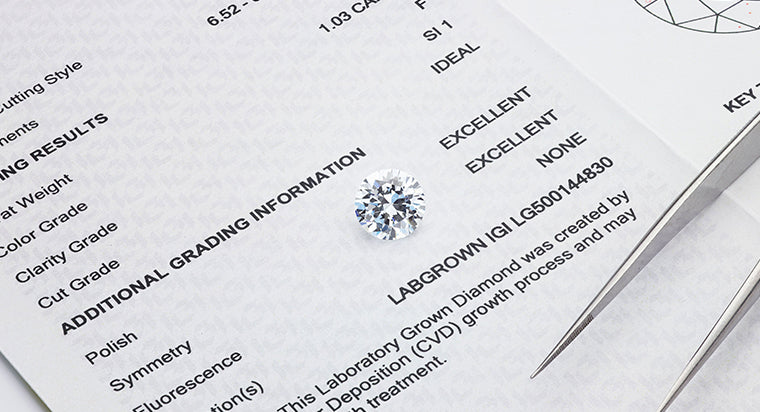Pros and Cons of Lab Grown Diamonds

You've likely heard the term lab diamonds before, but what exactly is a lab diamond? Lab grown diamonds are a “real” diamond that shares the same chemical composition, optical properties, and physical features as natural diamonds. Keep reading to learn more about how lab diamonds get created and some advantages and cons to lab diamonds. This information can determine if a lab-made diamond is right for you.
TABLE OF CONTENTS
How Lab Diamonds are Made
The first lab-made diamonds were made by GE in 1954, but it took years to perfect the process to create gem-quality lab-made diamonds. The process to create a lab grown diamond is somewhat similar to the process to create natural diamonds. Except one occurs within the earth's crust and the other is in a laboratory. The manufacturing process for lab diamonds replicates conditions used to create a natural diamond (extreme temperatures and pressures that turn carbon into a diamond).
Manufacturers create lab diamonds two ways, either by using High Pressure High Temperature (HPHT) or Chemical Deposition (CVD). Here's an explanation of each manufacturing process:
- HPHT: This method utilizes a diamond “seed” that's added to carbon. The diamond seed is a small, natural diamond fragment that undergoes extreme temperature and pressure conditions. In fact, the diamond seed and carbon's extreme temperatures are in excess of 1,300 to 1,600 degrees celsius and pressures of one million pounds per square inch. These extremes replicate the heat and pressure conditions deep within the earth where natural diamonds form. Then, carbon forms around the diamond seed and is then cooled.
- CVD: This process is a chemical vapor deposition system that begins with a diamond “seed.” The seed impacts the resulting lab diamond, so it's important to select the strongest and highest grade natural diamond piece in terms of color and clarity. During the CVD process, the diamond seed gets placed in a vacuum chamber and it's filled with gasses that are heavy in carbon. It's then heated to over 1,000 degrees, which turns the gasses into “plasma.” This plasma helps “build” the layers of the lab diamonds.
Lab Diamond Benefits
In addition to the unique processes to create lab diamonds, they also have some interesting benefits:
- While there are other stones that mimic diamonds, only lab-created diamonds give the “real” look and feel of a diamond. That's because they have the same chemical composition, optical properties, and physical features as natural diamonds.
- Selecting a lab-created diamond allows you to get a bigger diamond for an affordable price. They typically cost 30-50% less than an earth-mined diamond because the manufacturing process cuts out lengthy supply chains and eliminates expensive mining costs.
- Lab-created diamonds are conflict-free and eco-friendly. You can pinpoint where the lab-made diamond was created. While lab diamonds use energy to create them, the environmental impact is reduced. Mined diamonds impact environments, landscapes, and communities.
- The popularity of lab-created diamonds continues to increase. As a result, you'll see more jewelry options using lab-made diamonds, including tennis bracelets, earrings, engagement rings, anniversary bands, pendants, and necklaces.
- Lab-created diamonds are widely available and an ethical choice in diamonds.
Lab Diamond Cons
We can't mention all of the benefits of lab-created diamonds without mentioning their short list of cons.
Lab-made diamonds aren't as rare as natural diamonds, so their value depreciates over time. This will impact resale value if you want to sell your jewelry in the future.
Manufacturers have to use a tremendous amount of energy to create lab-made diamonds.
While they generate jobs for people in the labs, they don't help provide jobs and income for those working in diamond mines.
Lab Diamond vs. Earth Mined Diamonds: What Should You Pick?
Ultimately, you’ll have to weigh the pros and cons of lab and earth diamonds and decide what works best for you. Consider your budget, opinions of conflict-free diamonds, and environmental impact with diamond mining. Research the best place to buy lab-made diamonds and look at the brand's reputation, warranty, and return policy. Companies like With Clarity provide plenty of educational information to help you make the best decision for you.
FAQs
Is it worth buying lab diamonds?
Are lab diamonds better quality?
Do lab diamonds sparkle?
Can you insure lab diamonds?







